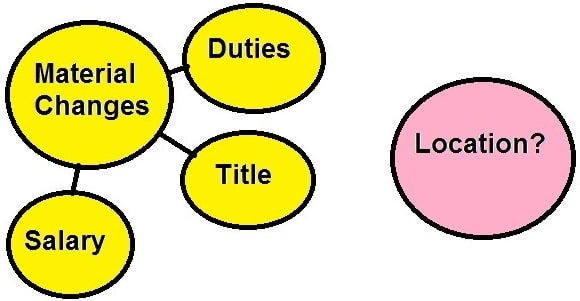H-1B Amendment for Location Change | Process, Fees
One of the hallmarks of the H-1B visa is the fact that it holds a few advantages over other nonimmigrant visa classifications. A chief advantage is its portability. Being able to change employers, work full or part time, and even work for multiple different employers simultaneously is a main reason why the H-1B is so competitive. However, you may not realize that you need an H-1B amendment for location change, even if it is with the same employer.
Due to the policy changes from the USCIS in recent years, employers of H-1B workers who are expected to change locations must take precautions before any type of relocation occurs. An amendment is necessary.
What is an H-1B Amendment?
There are several situations in which you would need to have your sponsoring employer file a new petition on your behalf. If your position is changing significantly or if you are changing employers altogether, a new petition is needed. This means that the USCIS will re-decide if you are qualified for your H-1B visa.
However, there are some circumstances where your employer would simply need to file to have your current petition amended. These include a change in job duties, a significant salary increase, or a change in title. In these instances, as long as the position is still considered a specialty occupation that requires your bachelor’s degree or higher, you should just need to have your petition amended.
But what about a change in job location? Do you need an H-1B amendment for location change, even with the same employer? We’ll take a look at how the USCIS has handled H-1B location changes in the past to see if an amendment is needed.
Former H1B Petition Procedures with Material Changes
The prior USCIS policy and interpretations allowed H-1B workers to relocate without an H-1B amendment. According to the INS Adjudicator’s Field Manual, if there were no ‘material changes’ within the terms and conditions of employment, an H-1B amendment was not mandated. It was, however, required to obtain a Labor Condition Application (LCA) for the new area of employment before relocation.
There are three main attestations that must be made for an LCA:
- That the employer will pay the H-1B employee at least the prevailing wage
- That the employment of the H-1B worker will not negatively impact the current workforce
- That the workers are not currently on strike
- That the current workers have been notified of the intention to hire the H-1B worker
The reason that a new LCA was required was that the LCA is dependent on the particular location and geographic positioning of the job. The prevailing wage for your position in one location may be much different than the wage in another. Also, this is to prevent employers from being able to hire you for one location where the workers are not on strike, just to move you to a location where they are.
Policy Interpretations of Location Change
Problems with the policy incur when the USCIS conducts a site visit to the employment location indicated on the H1B petition. Since the location changes are only submitted to the Department of Labor through the Labor Certification Application, the USCIS is unaware of any changes. Thus when the USCIS Fraud Detection and National Security (FDNS) group visits the area of employment, they visit the previous employment site. H1B’s employment legitimacy is then challenged.
Typically, when the FDNS visits a previous employment site, the USCIS submits a Notice of Intent to Revoke (NOIR) for noncompliance of the H1B terms and conditions.
If the H-1B worker has received a NOIR, the H-1B petition has the risk of being revoked. Some employers are able to solve the problem if they provide evidence of having filed a new LCA with the employee’s relocation in a timely manner.
Another rising issue that typically occurs is when IT consulting companies hire H-1B holders. Generally, consulting companies place their H-1B workers at different client locations. This causes the USCIS to doubt H-1B employer and employee compliance to H-1B regulations. According to the Adjudicator’s Field Manual, as long as the beneficiary maintains the same employer, salary, title, and duties he/she is not mandated to file an amended petition.
H-1B Amendment for Location Change
Though the USCIS has not stated specific regulation changes, due to the pattern of recent denials, it is highly advised to file an H-1B amendment when there is a change of the employee’s work location. The H-1B amendment must always be filed for any ‘material changes’ in the terms and conditions of employment. It would seem that the USCIS considers a change in location as a material change that requires an amendment.
The safe course of action is to file the H-1B amendment for location change. However, your immigration attorney can better assess your situation and advise you on the best thing to do.
When is an H-1B Amendment Required for a Location Change?
The following are examples of situations that may qualify for “material change” when an employee changes worksite locations, which will require filing an amendment:
- If the new worksite is not within the same metropolitan statistical area (MSA) covered by the initial H-1B petition and LCA.
- If the change of location will also involve any other material change. For instance, if the employee’s condition of employment or job title will also change. What constitutes as an H-1B material or immaterial change can sometimes be murky. It is best to have an immigration lawyer guide you on this based on your specific case.
When an H-1B Amendment May Not Be Required for Location Change
You may not need to file an H-1B amendment for change of location for an H-1B employee if:
- The employee is moving to a new worksite that is within the MSA or area of intended employment covered by the initial H-1B petition. However, the original LCA must still be posted at the new worksite. This step is required whether an employer is moving the entire workforce from one worksite to another within the MSA or it is just only one employee.
- The movement to a new location is just for short time placements, where the employee is only spending not more than 30 days, and in some cases, not more than 60 days.
- The H-1B worker is only moving to a “non-worksite” location. A location can be said to be “non-worksite” if:
- the employee’s purpose of going there is to participate in a staff seminar, management conference, or other employee-development activities;
- the employee will only spend a little time at any one location; or
- the job is “peripatetic in nature.” The USCIS defines peripatetic jobs as:
Such situations where [the employee’s] primary job is at one location but there is a need to embark on occasional travel for short periods to other locations on a casual, short-time basis, which can be recurring but not excessive.
-
- Specifically, one time visit by a peripatetic worker to such other locations should not exceed 5 consecutive days. As for workers who spend most work time at one worksite and travel occasionally to other locations, one time travel to such locations must not exceed 10 days.
Penalties for Not Filing an Amendment for Location Change When Necessary
If an H-1B amended petition for change of worksite locations is required and is not obtained, the consequences can be felt by both the employer and employee. For instance, the employee may lose his or her H-1B status and face deportation. It is therefore very important for employers to have a good understanding of the USCIS regulations regarding petition amendments.
When Should an Employer Submit the Amended Petition for Change of Worksite Locations?
Going by the Administrative Appeals Office (AAO) decision in 2015, employers are required to apply for an amendment when there is a material change to the initial petition. But, it did not expressly clarify if they should file the amendment before the movement takes place.
However, to be on the safe side, it is advisable that employers promptly notify the USCIS of any material change. So, therefore, it is recommended to file the amendment before the employee moves. In the event that the move has already taken place, the employer should start the amendment process as soon as possible.
How to File H-1B Amended Petition for Location Change
To apply for an H-1B amendment, the employer will need to submit an I-129 form to the USCIS.
To start, the employer should gather all the necessary information about the relocation, and include them in the H-1B Labor Condition Application (LCA). Typically, the Department of Labor (DOL) makes a decision on these cases within one week.
The next thing is to prepare the I-129 petition as well as other necessary supporting documents for the case such as:
- the employee’s H-1B visa
- a copy of the employee’s passport
- a copy of the employee’s I-94 form
- a copy of the H-1B employee’s updated resume
- copies of the employee’s three most recent payslips
- copies of the employee’s education degree
- the employee’s work itinerary
If you are using H-1B premium processing, you will need to submit an I-907 form with the petition.
H-1B Amendment FAQs
Should the amended petition be approved before an H-1B worker can move to a new location?
Again, the AAO decision is also silent on this question as it did not clarify whether employers should wait for approval of the amended petition before moving an employee to a new worksite location. However, an employer should at least try to submit the amendment before the move takes place. With that, the action will be easier to defend if the employer and/or employee are questioned during the USCIS worksite visit to their office.
What If the amended petition is denied?
If the amended H-1B petition is denied, it will not in any way affect the employee’s legal immigration status at the job location listed in the initial petition. With this, the H-1B worker will be able to return to the original worksite location and continue their job as long as the original H-1B petition is still valid.
Can I file another amended H-1B petition for location change if I still have an amended petition pending?
Yes, an employer can file another amended petition for change of worksite locations for an H-1B employee even if there is still another pending amended petition which the USCIS has not made a decision on. However, each amended petition must meet the criteria for H-1B classification. Also, keep in mind that, if the employee’s H-1B status expires while those petitions are still pending, the denial of any of the amended petitions will lead to the denial of all successive amended petitions.
What is the H-1B Amendment Processing Time?
Like the original H-1B petition, your amendment processing time will depend on the caseload of the service center that is processing it. A general rule of thumb is this: the closer it is to the H-1B filing season (April) the longer it will take to process your amendment. On average, it can take between 4 and 6 months to process your H-1B amendment, though it can take more or less time given the circumstances. Alternatively, you may be able to file the amendment with premium processing to reduce the processing time to 15 calendar days.






